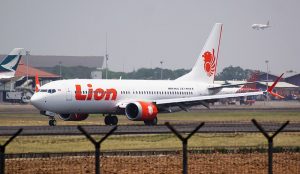 On October 29, 2018, a Lion Air flight traveling from Jakarta, Indonesia to Pangkal Pinang crashed into the Java Sea after experiencing a flight control problem minutes after departure. There were no survivors. The Republic of Indonesia’s Komite Nasional Keselamatan Transportasi (KNKT) recently published a preliminary report about Lion Air Flight 610.
On October 29, 2018, a Lion Air flight traveling from Jakarta, Indonesia to Pangkal Pinang crashed into the Java Sea after experiencing a flight control problem minutes after departure. There were no survivors. The Republic of Indonesia’s Komite Nasional Keselamatan Transportasi (KNKT) recently published a preliminary report about Lion Air Flight 610.
The report addresses concerns about the aircraft’s maintenance logs prior to Lion Air Flight 610 and summarizes nine logged defects over four separate flights. These errors occurred within the three days leading up to the crash. Out of the nine logged defects, three logs noted that speed and altitude flags appeared on the aircraft’s Primary Flight Display (PFD). Another log said that the aircraft’s Indicated Airspeed (IAS) and altitude disagreed. Two logs noted that the aircraft’s Speed Trim Fail light and Mach Trim Fail light illuminated during the flight. All of these errors could have made it difficult for the flight crews to maintain control of the aircraft.
According to data from Boeing’s Data Flight Data Recorder (DFDR), the aircraft’s angle of attack (AoA) sensors recorded a 20-degree difference after take-off. The DFDR also recorded that the aircraft initiated automatic Aircraft Nose Down (AND) at the beginning of the flight. The flight crew commanded subsequent Aircraft Nose Up (ANU) controls throughout the entirety of the flight. The aircraft’s anti-stall system has been a topic of concern.
It is important to note that investigators have not declared a cause of the crash. The cause continues to be under investigation. However, KNKT’s report provides the public with current and detailed information about the days and moments leading up to the crash.
Since the crash, Lion Air and The Boeing Company have issued safety notices about the Boeing 737 MAX 8 and its pitch trim system. The aircraft’s pitch trim system could cause the aircraft to nosedive for up to 10 seconds in an attempt to keep itself from stalling. According to the safety notices, after the flight crew corrects the pitch trim system manually, the aircraft could experience a five second delay before it corrects itself.
Right now, KNKT’s full report including crash analysis and their conclusion of the crash is estimated to be published in 2019. Determining fault in an aviation crash is difficult and takes time because of the multitude of factors to investigate. According to KNKT, investigators plan to further test the aircraft’s AoA sensor, analyze the aircraft’s Quick Access Recorder (QAR) and run aircraft simulator exercises. At the time of publication, the cockpit voice recorder (CVR) had not been found and investigators are searching for it.
The attorneys at Colson Hicks Eidson have previously handled cases against aviation companies and manufacturers. We have litigated against Lion Air and The Boeing Company in the past. We recently filed a lawsuit against The Boeing Company on behalf of our clients who lost their son on Flight 610.
Follow our blog and Facebook page to learn more about the Lion Air Flight 610 crash and our lawsuit against Boeing.





